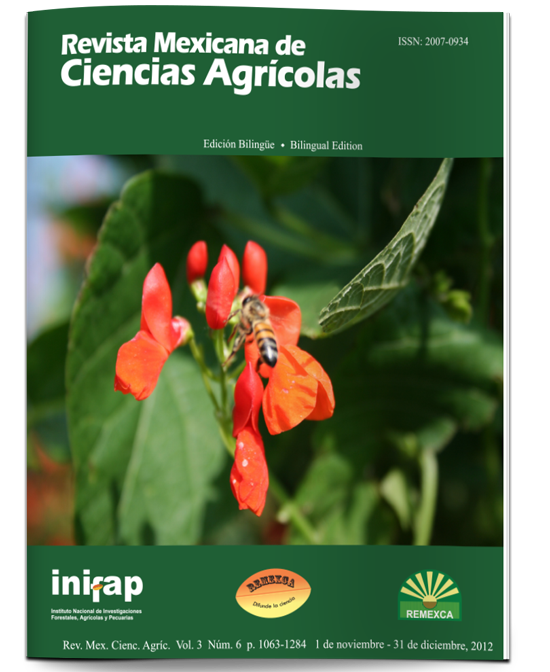Maize floral development in vitro during the induction and shoot multiplication
DOI:
https://doi.org/10.29312/remexca.v3i6.1370Keywords:
Zea mays L., auxins, cytokinins, female inflorescences, type and hormonal doseAbstract
In vitro culture for f loral induction has an advantage because of the ease of applying various stimuli that induce or inhibit this phenomenon without involving environmental factors (Scorza, 1982). High yields in maize as in many crops depend primarily on the number of grains per plant produced and has been observed that the number of ears is determined by endogenous growth regulators (Leal-Leon et al., 2002). During direct organogenesis in vitro of corn obtained from the base of the coleoptile female reproductive structures are generated at an early stage, which is a problem in the induction and in vitro multiplication of shoots of corn due to competition for the assimilation of components of the culture medium (Iracheta et al., 2003). In the Graduate College in Agricultural Sciences in 2006 studied the role of phytohormones in floral development of maize lines in the induction and shoot multiplication trying different cytokinins at different doses and in combination with two doses of indole acetic acid. The lines tested differed in their morphogenic capacity, being the maize lines L13 and L14 which showed the highest shoot induction capacity. Floral initiation was detected between 10 and 15 d from seeding explants. The development of female inf lorescences depended on the type of cytokinin (highest to lowest response): BAP> KIN> TDZ. With ZEA and 2iPA only induce and multiply vegetative shoots.
Downloads
Downloads
Published
How to Cite
Issue
Section
License
The authors who publish in Revista Mexicana de Ciencias Agrícolas accept the following conditions:
In accordance with copyright laws, Revista Mexicana de Ciencias Agrícolas recognizes and respects the authors’ moral right and ownership of property rights which will be transferred to the journal for dissemination in open access. Invariably, all the authors have to sign a letter of transfer of property rights and of originality of the article to Instituto Nacional de Investigaciones Forestales, Agrícolas y Pecuarias (INIFAP) [National Institute of Forestry, Agricultural and Livestock Research]. The author(s) must pay a fee for the reception of articles before proceeding to editorial review.
All the texts published by Revista Mexicana de Ciencias Agrícolas —with no exception— are distributed under a Creative Commons License Attribution-NonCommercial 4.0 International (CC BY-NC 4.0), which allows third parties to use the publication as long as the work’s authorship and its first publication in this journal are mentioned.
The author(s) can enter into independent and additional contractual agreements for the nonexclusive distribution of the version of the article published in Revista Mexicana de Ciencias Agrícolas (for example include it into an institutional repository or publish it in a book) as long as it is clearly and explicitly indicated that the work was published for the first time in Revista Mexicana de Ciencias Agrícolas.
For all the above, the authors shall send the Letter-transfer of Property Rights for the first publication duly filled in and signed by the author(s). This form must be sent as a PDF file to: revista_atm@yahoo.com.mx; cienciasagricola@inifap.gob.mx; remexca2017@gmail.
This work is licensed under a Creative Commons Attribution-Noncommercial 4.0 International license.



